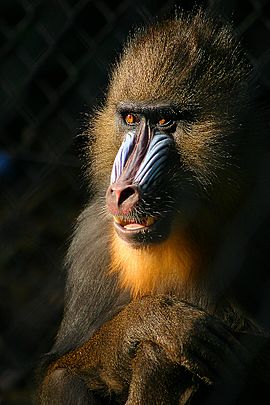Cercopithecine monkeys facts for kids
Quick facts for kids Cercopithecine monkeys |
|
|---|---|
 |
|
| Mandrill (Mandrillus sphinx) | |
| Scientific classification |
|
| Kingdom: | Animalia |
| Phylum: | Chordata |
| Class: | Mammalia |
| Order: | Primates |
| Suborder: | Haplorhini |
| Infraorder: | Simiiformes |
| Family: | Cercopithecidae |
| Subfamily: | Cercopithecinae Gray, 1821 |
| Tribes | |
|
Cercopithecini - 5 Genera |
|
The Cercopithecinae are a large group of Old World monkeys. They are a "subfamily," which is like a big family group in the animal kingdom. This group includes famous monkeys like baboons, macaques, and vervet monkeys.
There are about 12 different genera (smaller groups of species) and around 71 different species (types) of these monkeys! Most of them live in sub-Saharan Africa. However, macaques can be found much further away. Their homes stretch from eastern Asia all the way to northern Africa and even Gibraltar.
Contents
What Makes Cercopithecine Monkeys Special?
These monkeys have many cool features that help them live in different places.
Body Features and Adaptations
Monkeys that live in trees are often slim and have long tails. These tails help them balance as they swing and climb. Monkeys that live mostly on the ground are usually heavier. Their tails might be short or even missing! All species have strong, well-developed thumbs. These thumbs help them grab food and climb.
Many Old World monkeys, including these, have special pads on their bottoms. These pads are called ischial callosities. They are like built-in cushions! These pads allow the monkeys to sleep sitting upright on thin branches. This keeps them safe from predators on the ground. In some species, these pads can even change color during certain times of the year.
Daily Life and Habitat
Cercopithecine monkeys are active during the daytime. They live together in social groups, which means they spend time with other monkeys. You can find them in many different types of places. They live everywhere from cool mountains to warm rain forests and savannah grasslands. Some, like the Japanese macaque, even live in snowy mountains!
What They Eat
Most of these monkeys are omnivorous. This means they eat both plants and animals. Their diet can include fruits, leaves, seeds, buds, and mushrooms. They also enjoy insects, spiders, and sometimes even small animals. A cool fact is that all these monkeys have special cheek pouches. They can store extra food in these pouches to eat later!
Life Cycle
Baby monkeys grow inside their mothers for about six to seven months. After they are born, they drink their mother's milk for three to 12 months. They become fully grown adults when they are about three to five years old. Some species of these monkeys can live for a very long time, up to 50 years!
More About These Monkeys

